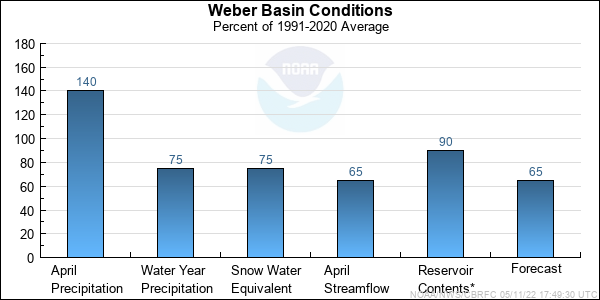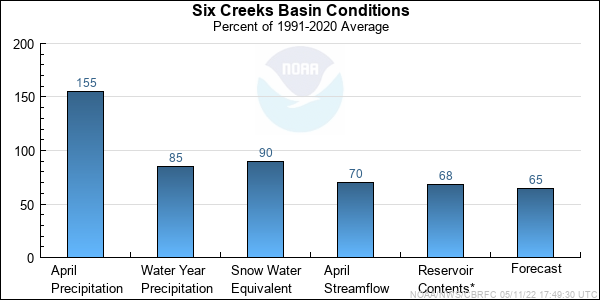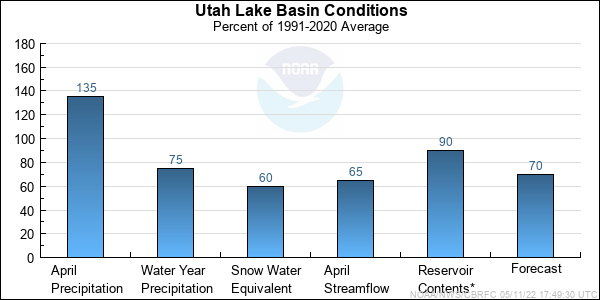
NOAA, National Weather Service
Colorado Basin River Forecast Center
Salt Lake City, Utah
www.cbrfc.noaa.gov
 | Prepared by B.Bernard NOAA, National Weather Service Colorado Basin River Forecast Center Salt Lake City, Utah www.cbrfc.noaa.gov |





| Forecast Period | 90% Exceedance Volume | 50% Exceedance Volume | Percent Average | 10% Exceedance Volume | |
| Bear | |||||
| Utah | April-July | 75 | 89 | 79 | 101 |
| May-July | 72 | 84 | 81 | 97 | |
| Woodruff Narrows Rsvr, Abv | April-July | 70 | 88 | 73 | 101 |
| May-July | 55 | 73 | 70 | 86 | |
| Montpelier, Nr, Stewart Dam, Blo * | April-July | 40 | 60 | 33 | 81 |
| May-July | 31 | 50 | 34 | 71 | |
| Big Ck | |||||
| Randolph, Nr | April-July | 1.2 | 2.8 | 58 | 3.8 |
| May-July | 0.9 | 2.5 | 58 | 3.5 | |
| Smiths Fork | |||||
| Border, Nr | April-July | 45 | 58 | 65 | 69 |
| May-July | 38 | 51 | 64 | 62 | |
| Logan | |||||
| Logan, Nr, State Dam, Abv | April-July | 61 | 70 | 63 | 79 |
| May-July | 51 | 60 | 63 | 69 | |
| Blacksmith Fork | |||||
| Hyrum, Nr, Upnl Dam, Abv | April-July | 21 | 24 | 56 | 27 |
| May-July | 16 | 18 | 58 | 21 | |
| Little Bear | |||||
| Paradise | April-July | 15 | 18 | 38 | 22 |
| May-July | 8.7 | 11 | 34 | 15.2 |
| Forecast Period | 90% Exceedance Volume | 50% Exceedance Volume | Percent Average | 10% Exceedance Volume | |
| Little Cottonwood Ck | |||||
| Salt Lake City, Nr | April-July | 28 | 32 | 84 | 37 |
| May-July | 25 | 30 | 86 | 35 | |
| Big Cottonwood Ck | |||||
| Salt Lake City, Nr | April-July | 25 | 29 | 81 | 37 |
| May-July | 22 | 26 | 81 | 33 | |
| Mill Ck | |||||
| Salt Lake City, Nr | April-July | 3.4 | 4.2 | 66 | 5.5 |
| May-July | 2.9 | 3.6 | 67 | 4.9 | |
| Dell Fk | |||||
| Little Dell Res | April-July | 3.1 | 3.7 | 67 | 4.8 |
| May-July | 2.6 | 3.2 | 82 | 4.3 | |
| Parleys Ck | |||||
| Salt Lake City, Nr | April-July | 7.6 | 9 | 63 | 11.4 |
| May-July | 5.7 | 7 | 66 | 9.4 | |
| Emigration Ck | |||||
| Salt Lake City, Nr | April-July | 1.7 | 2.1 | 53 | 2.8 |
| May-July | 1.1 | 1.5 | 56 | 2.2 | |
| City Ck | |||||
| Salt Lake City, Nr | April-July | 4.6 | 5.4 | 70 | 6.7 |
| May-July | 3.8 | 4.6 | 71 | 5.9 | |
| Vernon Ck | |||||
| Vernon, Nr | April-June | 0.4 | 1 | 0 | 1.1 |
| May-June | 0.2 | 0.8 | 0 | 1.6 | |
| S Willow Ck | |||||
| Grantsville, Nr | April-July | 2.2 | 2.7 | 87 | 3.4 |
| May-July | 1.8 | 2.3 | 85 | 3 | |
| Dunn Ck | |||||
| Park Valley, Nr | April-July | 0.3 | 1.5 | 48 | 3.8 |
| May-July | 0.1 | 1.3 | 46 | 3.6 |
| Forecast Period | 90% Exceedance Volume | 50% Exceedance Volume | Percent Average | 10% Exceedance Volume | |
| Spanish Fork | |||||
| Castilla, Nr | April-July | 40 | 45 | 65 | 50 |
| May-July | 30 | 35 | 65 | 40 | |
| Provo | |||||
| Woodland, Nr | April-July | 62 | 72 | 72 | 86 |
| May-July | 55 | 65 | 73 | 79 | |
| Hailstone, Nr | April-July | 63 | 76 | 76 | 92 |
| May-July | 54 | 67 | 77 | 83 | |
| Deer Ck Res | April-July | 68 | 88 | 76 | 105 |
| May-July | 53 | 69 | 73 | 86 | |
| American Fork | |||||
| American Fork, Nr, Up Pwrplnt, Abv | April-July | 19 | 23 | 74 | 26 |
| May-July | 17 | 21 | 75 | 24 | |
| West Canyon Ck | |||||
| Cedar Fort, Nr | April-July | 0.41 | 0.92 | 52 | 1.8 |
| May-July | 0.4 | 0.9 | 58 | 1.8 | |
| Salt Ck | |||||
| Nephi | April-July | 3.9 | 6.6 | 69 | 10.5 |
| May-July | 3.3 | 6 | 79 | 9.9 | |
| Jordan | |||||
| Utah Lake, Provo, Nr | April-July | 177 | 215 | 68 | 255 |
| May-July | 110 | 150 | 63 | 190 |
| Range | Round to | |
| 0-1.99 | 0.01 | |
| 2.0-19.9 | 0.1 | |
| 20-199 | 1.0 | |
| 200-999 | 5.0 | |
| 1000+ | 3 significant digits |